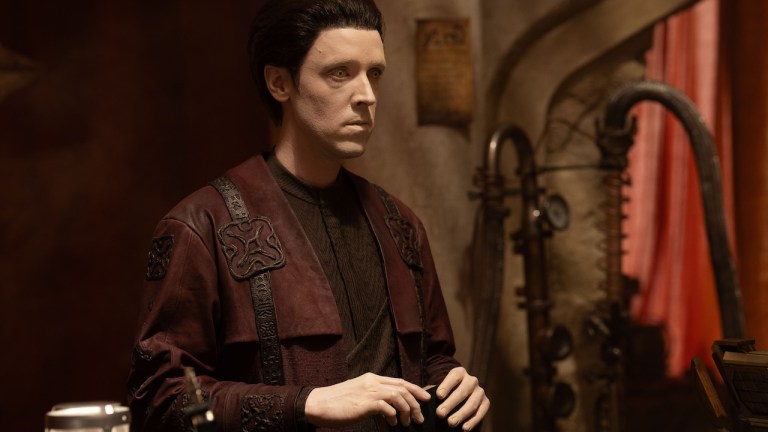Star Trek: Discovery Is Now Connected to a Franchise-Defining Next Generation Episode
Star Trek: Discovery beings season five with a treasure hunt, one that recalls The Next Generation episode "The Chase" and the Progenitors.

This Star Trek: Discovery article contains spoilers.
At the end of the Star Trek: Discovery season five premiere “Red Directive,” Dr. Kovich finally levels with Captain Burnham. The mission that she and her crew had been on throughout the episode has escalated beyond even Admiral Vance’s clearance, to a level that only someone as deep within the Federation as Kovich can understand.
The mission involves the Progenitors, the source of all humanoid life in the universe. “A few thousand years ago, we’d have found them gods,” says Kovich. But to long-time Trekkies, the Progenitors are also the topic of a remarkable episode of Star Trek: The Next Generation.
As much as we all love Star Trek and its wild world of alien races, the fact remains that the large majority of those aliens are just regular-looking humans with different bits of putty slapped on their foreheads. Romulans, Klingons, and Bajorans — the difference between them is minor. Even the more ornate aliens, such as the Cardassians or Saurians like Lieutenant JG Linus of the USS Discovery are humanoid. More out there races, such as the Medusans, are few and far between.
Back in the 1960s, the reason for these similarities was simple. The Original Series had very limited budgets, which meant that Gene Roddenberry couldn’t get so crazy with alien designs. And while bigger budgets for the movies and The Next Generation allowed for the Klingons to develop into more complex designs, they still remain very similar to humans.
While the fact that most aliens in Star Trek are humanoids never really bothered most fans, a season six episode of TNG provided an explanation for why so many races are so similar in this universe. Written by Joe Menosky and Ronald D. Moore and directed by Jonathan Frakes, “The Chase” sent the Enterprise on an archeological quest that Captain Picard couldn’t resist.
Following the work of his mentor Professor Galen, Picard discovers material from a founding species called the Progenitors, whose genetic code has been transmitted into various successor races, accounting for their similarities. As the Enterprise searches for the missing DNA fragment in that code, it finds other vessels on the same trail. Working together, the humans, Klingons, Cardassians, and Romulans find a holographic projection of one of the Progenitors. This figure explains the shared history of the gathered delegates, and expresses their people’s desire that the connection would create peace in the universe.
Of course, that peace between the gathered races doesn’t occur until the Dominion War in Deep Space Nine, which saw the various groups band together to fight invaders from the Gamma Quadrant. But given the fractured state of the universe in the 32nd century of Discovery, the time might be right for another attempt at cooperation.
Kovach’s speech to Burnham includes images from “The Chase,” including a close-up of one of the Romulan scientists who participated in the search. Dr. Vellek, “one of the greatest scientists of his day,” according to Kovich. It was Vellek’s journal that the Discovery has been looking for, after being stolen from an ancient Romulan vessel by thieves Moll and L’ak. Why is it so important? The journal contains the location of the machinery that the Progenitors used to create life.
We don’t know much about this weapon yet, but Trekkies cannot help but recall the Genesis device from Star Trek II: The Wrath of Khan. Genesis could create life but also be used as a weapon. The second episode of Discovery‘s fifth season “Under the Twin Moons” finds the crew wrestling with that realization regarding the Progenitor, as they search the planet Lyrek for Moll and L’ak.
Discovery executive producers Alex Kurtzman and Michelle Paradise have been quite open about the focus of this fifth season, telling Den of Geek that Burnham and crew will be on a “quest.” But by tying the object of the quest to “The Chase,” the goal becomes more than a mere MacGuffin. Rather, the Progenitor device serves as a referendum on Discovery in its final season.
The device can be a tool of destruction, recalling the darker and more violent first seasons of the series. Or it can be a means for peace, culminating with the spirit of cooperation and community that Star Trek has always imagined.
“Well, Captain,” Kovich tells Burnham. “The greatest treasure in the known galaxy is out there. What are you waiting for?” By bringing back the stakes of “The Chase,” Discovery pays off the promise of the episode, freeing it from an unnecessary canonical explanation (not unlike the Enterprise episode “Divergence”), and allows it to be a statement of purpose. And frankly, we cannot wait to see how Discovery pulls it off.
Star Trek: Discovery is streaming now on Paramount+.
